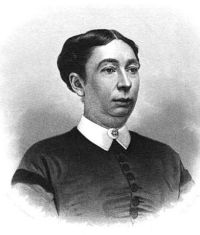Bucklin’s Hospital & Camp: “Bring Pen and Ink and Paper” (Part 3)

In Hospital and Camp, A Woman’s Record of Thrilling Incidents Among the Wounded in the Late War by Sophronia E. Bucklin
Joining us for Week 3 of the read-along? You can find the free e-book and we’re on chapters five and six this weekend.
Chapter 5
The previous chapter ended with the spoiler that Miss Bucklin was heading for the hospital at Point Lookout, Maryland, and Chapter 5 begins with details of her journey along the Potomac River.
George Washington, a beloved figure to the North and South, still commanded great respect. His home—Mount Vernon—was an unofficial neutral ground and stories reference Union and Confederate soldiers peacefully meeting on the property by accident when both parties were touring the first president’s land. Bucklin references the Mount Vernon Ladies’ Association which was the first formal preservation organization in the United States; started in 1853, they raised $200,000 in five years to preserve and restore the house and purchase 200 acres of the plantation.
Dr. Wagner is referenced several times at Point Lookout Hospital in this memoir. Did you know he was involved with collecting specimens for the medical museum? Yep, teams of surgeons helped create a collection of human anatomy for scientific research. (Guess where Dan Sickle’s leg went?) Here’s a letter written on December 23, 1862, during the same period that Miss Bucklin was at the hospital:
Dear Doctor,
Your letter requesting me to preserve specimens for the Museum has been rec’d. I received last week eleven hundred wounded, I have already performed a number of interesting operations, resections, amputations etc[?] – I have more in prospect – the specimen in each case has been preserved- I intend keeping them until the results in each case is known. I would suggest that you have a circular issued giving us instructions as to the manner of preparing them, whether wet or dry – rest assured I will do all in my power to enrich your collection.
Very truly,
Yours, &c.,
C. Wagner
September 30, 1830: that was the first day the light was illuminated at Point Lookout Lighthouse, Maryland. During the Civil War years, Pamelia Edwards served as the lightkeeper. Women were allowed to keep lights and drew a paycheck from the federal government for this work, one of the few opportunities like this in mid-19th Century America. The lighthouse still stands today and is sometimes open for tours.
Catholic nuns volunteered in Civil War hospitals and some even journeyed directly to battlefields, like Gettysburg. This period sketch shows a Sister of Charity comforting an injured soldier and sharing or encouraging religious faith.
The families of “Contraband”—escaped enslaved sheltering within the Union lines—faced limited opportunity. For many it was a battle of survival with no clear way to work or permanent home. Nurse Bucklin is rather harsh in her descriptions of their situation and seeming lack of interest in work, but sometimes racism and lack of opportunity severely compounded the situation.
Chapter 6
Thanksgiving traditionally held greater importance that Christmas in New England, though that holiday trend was starting to shift the 1860’s. In most northern hospitals, some type of Thanksgiving celebration was held and Point Lookout was not exception in 1862.
Communication with family and friends on behalf of the patient has always been an important part of a nurse’s work. For the wounded arriving from the Battle of Fredericksburg, the hospital ward was probably the first time they felt safe and had a real opportunity to write or ask someone to write home for them:
“Bring pen and ink and paper, that I may let them know at home that I still live, though I lie weak, maimed, and helpless on a hospital bed!”
Dorothea Dix had power to protect female nurses within her program. But she was not omnipresent and could not handle every situation. As Buckline explains, a hospital surgeon held the immediate power within the facility, and his decision to accept or make life difficult for female nurses controlled the immediate moment. Some—like this ward surgeon that Bucklin praises—were willing to work with the nurses, but others felt threatened by women entering military medicine and made life miserable in other wards.
The surgeon in charge of this ward, when I ?rst entered it, was a ?ne, generous-hearted man, who was interested in everything pertaining to the welfare of his men, and he gave me unstinted orders for sugar, butter, eggs, and other articles, with which I could prepare delicacies for the faint appetites, which revolted at the food sent up from the general cook-house. The ward master also had it in his power to give us a world of annoyance, but, fortunately, the one in charge of my beat was a co-worker with the surgeon in all efforts to promote the comfort of the men.
To be continued next weekend…
Sources:
Mount Vernon history: https://www.mountvernon.org/preservation/mount-vernon-ladies-association/
National Museum of Health and Medicine; post of Dr. Wager’s letter: https://www.facebook.com/MedicalMuseum/posts/its-letterwritingday-this-letter-sent-in-the-early-days-of-the-civil-war-from-as/10157231097342697/
Point Lookout Lighthouse: https://www.lighthousefriends.com/light.asp?ID=436


1 Response to Bucklin’s Hospital & Camp: “Bring Pen and Ink and Paper” (Part 3)